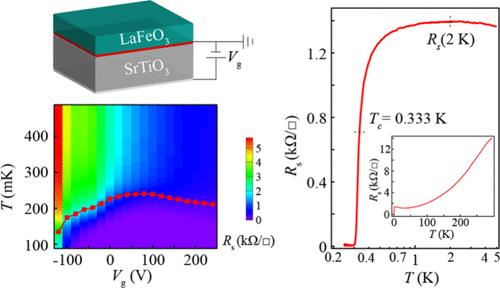LaFeO3/SrTiO3界面上的二维超导电子气
IF 9.1
1区 材料科学
Q1 CHEMISTRY, MULTIDISCIPLINARY
引用次数: 0
摘要
过渡金属氧化物界面由于其迷人的特性而引起了人们的极大关注。这些界面的高迁移率和超导性与磁性的共存仍然是值得关注的研究课题。本文首次报道了在LaFeO3/SrTiO3界面处形成的2DEG超导,其超导转变温度(Tc)为333 mK,超导层厚度为13.7 nm。低温下Berezinskii-Kosterlitz-Thouless跃迁的观察表明了超导的二维性质。这种二维超导性可以通过在SrTiO3衬底上施加栅极电压(Vg)来调节,显示出圆顶形状的Tc-Vg依赖关系。此外,在超导状态下,我们观察到磁电阻的滞后行为,其潜在的机制有待进一步研究。我们的研究结果揭示了2DEG在LaFeO3/SrTiO3界面上的超导特性,并为研究氧化物界面上的紧急量子现象提供了一个新的引人注目的平台。本文章由计算机程序翻译,如有差异,请以英文原文为准。

A Two-Dimensional Superconducting Electron Gas at LaFeO3/SrTiO3 Interfaces
Transition metal oxide interfaces have garnered great attention due to their fascinating properties that are absent in their bulk counterparts. The high mobility and coexistence of superconductivity and magnetism at these interfaces remain compelling research topics. Here, we first report superconductivity in the 2DEG formed at the LaFeO3/SrTiO3 interfaces, characterized by a superconducting transition temperature (Tc) of 333 mK and a superconducting layer thickness of 13.7 nm. The observation of a Berezinskii-Kosterlitz-Thouless transition at low temperatures indicates the two-dimensional nature of the superconductivity. Such two-dimensional superconductivity can be tuned by applying a gate voltage (Vg) across the SrTiO3 substrate, showing a dome-shaped Tc–Vg dependence. Moreover, we observe a hysteretic behavior in the magnetoresistance in the superconducting regime, and the underlying mechanism requires further investigation. Our results unveil the superconducting characteristics of 2DEG at LaFeO3/SrTiO3 interfaces and offer a new compelling platform to investigate emergent quantum phenomena at oxide interfaces.
求助全文
通过发布文献求助,成功后即可免费获取论文全文。
去求助
来源期刊

Nano Letters
工程技术-材料科学:综合
CiteScore
16.80
自引率
2.80%
发文量
1182
审稿时长
1.4 months
期刊介绍:
Nano Letters serves as a dynamic platform for promptly disseminating original results in fundamental, applied, and emerging research across all facets of nanoscience and nanotechnology. A pivotal criterion for inclusion within Nano Letters is the convergence of at least two different areas or disciplines, ensuring a rich interdisciplinary scope. The journal is dedicated to fostering exploration in diverse areas, including:
- Experimental and theoretical findings on physical, chemical, and biological phenomena at the nanoscale
- Synthesis, characterization, and processing of organic, inorganic, polymer, and hybrid nanomaterials through physical, chemical, and biological methodologies
- Modeling and simulation of synthetic, assembly, and interaction processes
- Realization of integrated nanostructures and nano-engineered devices exhibiting advanced performance
- Applications of nanoscale materials in living and environmental systems
Nano Letters is committed to advancing and showcasing groundbreaking research that intersects various domains, fostering innovation and collaboration in the ever-evolving field of nanoscience and nanotechnology.
 求助内容:
求助内容: 应助结果提醒方式:
应助结果提醒方式:


